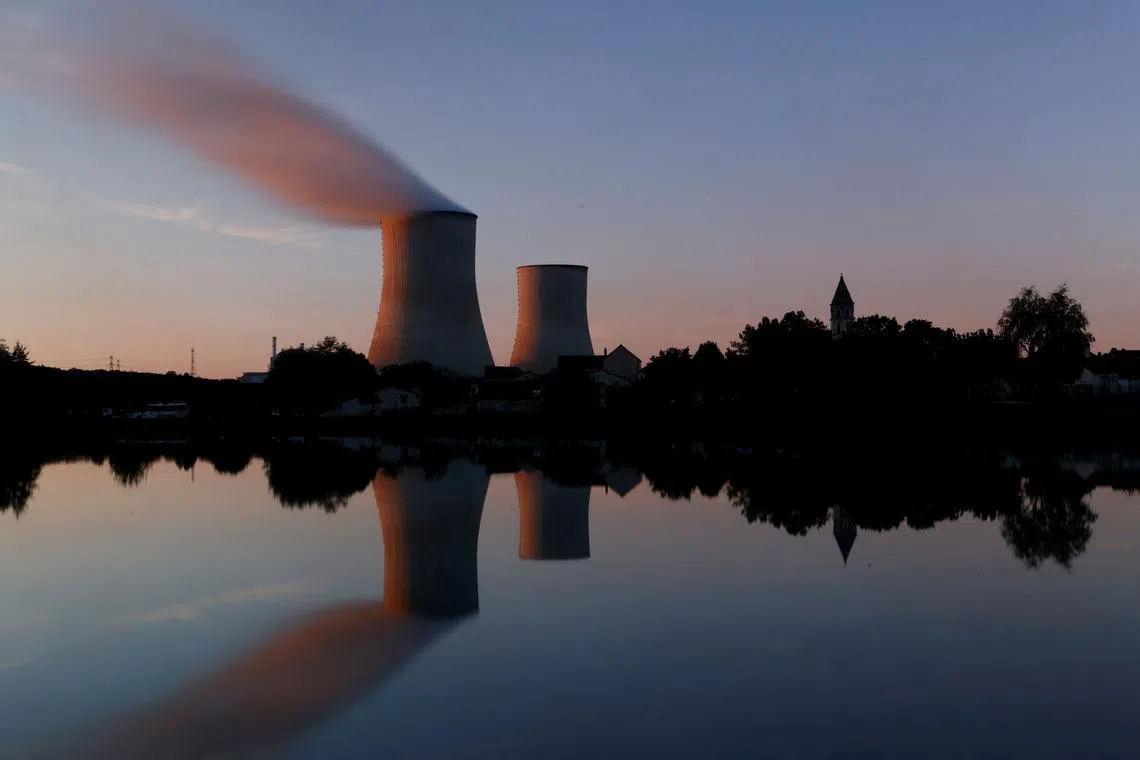Asian Insider
Asean can power its green future without nuclear energy, say experts
Sign up now: Get insights on Asia's fast-moving developments

Steam rising from a cooling tower of the Electricite de France nuclear power station in Civaux, France, on Oct 8, 2021.
PHOTO: REUTERS
Follow topic:
SINGAPORE - Across Asean, energy security unites all 10 members, especially after the war in Ukraine
The region of 660 million people, one of the world’s fastest-growing energy markets, faces an increasingly urgent dilemma: how to meet rapidly growing energy demands in a way that is affordable, reliable and meets stringent climate goals, particularly in its fast-growing power generation sector?
Nuclear power, with its low-carbon footprint, is one option being discussed by some governments. But experts say a sharp increase in renewable energy investment is the only way to go for Asean to avoid rising fossil fuel import costs, air pollution and soaring greenhouse gas emissions that are heating up the planet.
Experts The Straits Times spoke to said nuclear is unlikely to play a role over the next several decades because of costs, time needed to build nuclear power plants and develop the industry around them, and lingering safety fears.
“While we need all the tools in our toolbox for decarbonisation, so far nuclear has been too slow and too expensive,” said Mr Putra Adhiguna, an energy analyst at the Institute for Energy Economics and Financial Analysis think-tank. “While the cost of renewables and battery storage have dropped significantly in the past decades, the cost of nuclear plants has been growing.”
Mr Ahmed Saeed, the Asian Development Bank’s (ADB) vice-president for regional operations in East and South-east Asia and the Pacific, put the argument against nuclear power succinctly: “We are... staying away from nuclear investments given the many barriers to its deployment, including risks related to nuclear proliferation, waste management and safety issues, and very high investment costs relative to ADB’s resources.”
For these reasons, the bank is not funding nuclear power despite its recognition of the role nuclear power can play in the transition towards clean energy, given its ability to provide low-carbon baseload electricity, or the minimum amount of power needed to be supplied to an electric grid at any given time, eliminating the problem of intermittency in renewables such as solar and wind.
Instead, the bank will direct its resources to supporting non-nuclear generation of power as well as its transmission and distribution, Mr Saeed added.
The question is whether without nuclear power, the region can transition quickly enough to clean energy to meet its burgeoning energy needs and emissions goals.
Six of the 10 Asean members have announced mid-century net-zero emissions and carbon neutrality targets. This means in a matter of a few decades, the region’s energy system has to be transformed to a low-carbon one.
Fossil fuels dominate the region’s energy mix now, accounting for about 83 per cent in 2020, compared with 14.3 per cent renewables, excluding traditional biomass, the Asean Centre for Energy (ACE) said in a paper, the 7th Asean Energy Outlook, released in September.
Yet the region is one of the most vulnerable in the world to climate change, such as more intense typhoons, floods and droughts.
The Asean energy paper said that without new energy policies, the region’s greenhouse gas emissions are projected to reach 6.7 billion tonnes of carbon dioxide-equivalent per year in 2050, up from 1.82 billion tonnes in 2020, making it one of the top polluting regions on the planet. The paper’s most conservative baseline scenario projects that electricity generation needs to grow by a factor of three between 2020 and 2050.
However, green energy’s share in the region’s electricity generation is growing, especially solar and hydropower. The total renewable energy share based on installed capacity grew from 19.1 per cent in 2005 to 32.4 per cent in 2020.
ADB’s Mr Saeed noted that regionwide, clean energy can be competitive with and comparable to existing fossil fuel systems, and that what is needed is aligning investor incentives with the energy transition to meet development and climate needs.
Mr Putra and Mr Beni Suryadi, ACE’s manager of power, fossil fuel, alternative energy and storage, said the region needs better cooperation, such as building a regional grid to efficiently distribute green power, greater access to finance, and policies that promote investment in green energy.
Singapore could play a role as financier and driver of demand for clean energy. “Singapore’s plans to procure multi-gigawatts of green electricity supply could provide a good nudge for Asean,” Mr Putra said, pointing to plans to import renewable energy.
Policies that promote greater energy efficiency are also vital, said ACE in its energy paper, because this would reduce future demand growth and curb the amount of investment needed. It would also cut fossil fuel imports.
Energy efficiency measures include more efficient lighting, cooling and appliances in homes and offices, better fuel economy standards and large-scale deployment of electric vehicles.
Major shifts in policies and financial support are also required.
Mr Beni said incentives that make renewable energy projects bankable include member states introducing feed-in tariffs, which guarantee long-term returns for green energy, tradeable renewable energy certificates, and carbon and production taxes.
“Public investment, loans, grants, capital subsidies, or rebates are also meaningful, wherein government or private investors finance renewable energy and clean energy projects,” he added.
Phasing down costly fossil fuel subsidies is also vital, analysts say, as these undermine green energy investment.
Transitioning to green energy will not come cheap, however, with the International Renewable Energy Agency saying in a paper in September that it would cost the region more than US$5 trillion (S$7 trillion) by 2050.
The belief of some analysts is that the region can transition to clean energy without adding nuclear power to its energy mix provided it takes the necessary actions.
The ACE energy paper in its most ambitious regional policy and investment scenario envisages that 63.2 per cent of the region’s electricity demand in 2050 will be generated from renewable energy, including hydropower, solar, wind, geothermal and biofuels.
“The remainder will be coming from fossil fuels, such as natural gas and coal, but no nuclear development is expected,” said Mr Beni, one of the co-authors of the paper.





